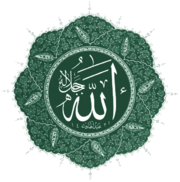- Najamuddin Ahmed
-
Khwaja Najamuddin Ahmed Mushtaq Bin Moudodi Chishti (507-577, Hijri in Chishti Sharif Afghanistan) was a sufi saint.[citation needed] A part of the Chishti Order (Persian: چشتی - Čištī), a Sufi order within the mystic branches of Islam which was founded in Chisht, a small town near Herat, about 930 C.E. and continues to this day (2008). The Chishti Order is known for its emphasis on love, tolerance, and openness.[1]
This article is part of the series: Islam 
Contents
Life Events
Khwaja Najamuddin Ahmed was born in Chisht, an area well known for being the birth place of a long line of sufi saints. Khwaja Najamuddin Ahmed was a Sufi saint, well versed in wisdoms of the realms of visible and hidden. His name was Ahmed but he came to be known by the name Najam-ud-din Ahmed Mustaq. The title 'Mustaq' which actually means 'anxious' to meet an absent friend' was granted to him by the Prophet, in a vision. He was born in 507 A.H and succeeded his father after his death as his successor. After performing Hajj, he stayed at Medina for six months. When a group of people, who were jealous of his popularity among the locals tried to force him to leave a voice spoke from with in the shrine of Prophet Mohammed, that no one should harm my follower. Everyone present at the time heard this voice. He lived at Madina for a long time and when he returned, he visited Shiekh Shahabud-din Umar Soharwardy at Baghdad. The Shiekh gave him due respect and he stayed there for a few days. It is said that the Caliph al-Mustazhar Billah invited him to his palace and offered many gifts. The Khwaja, however distributed all among the poor and left to Khurasan. He financially supported the whole clan of his Khwaja-gan and looked after the poor of the region. He died in 507 A.H. and was buried at Chisht.
Family tree
- Imam Ali ibn Abu Talib, buried at the Imam Ali Mosque in Najaf , Iraq .{March 17, 599 - February 28, 661 aged 61}
- Imam Husayn ibn Ali, buried at the Imam Husayn Shrine in Karbala, Iraq. (B4h D60h)
- Imam Hassan ibn Alial-Sajjad, Zainu l-Abidin, buried in Jannat al-Baqi Medina.(B-h D94h)
- Imam Muhammad ibn Ali al-Baqir al-Ulum Buried in Jannat al Baqi Medina.(B-h D114h)
- Imam Ja'far al-Sadiq al-Sadiq - in Jannat al-Baqi Medina.(B80h D148h)
- Imam Musa al-Kadhimal-Kazim in the Kadhimiya in Baghdad Iraq .(B128h D183h)
- Imam Ali ibn Musa ar-Rida in the Imam Reza shrine Mashad.(B153h D203h)
- Imam Muhammad ibn Ali at-Taqi al-Jawad in the Kadhimiya in Baghdad Iraq.(B195h D220h)
- Imam Ali al-Hadi an-Naqi in the Al Askari Mosque in Samarra Iraq.(B214h D254h)
- Abdullah Ali Akbar. (B238h D292h)
- Abu Muhammed Al Hussain in Chist Hirat Afghanistan. (B---h D352h)
- Abu Abdullah Muhammed in Chisht Herat Afghanistan. (B270h D324h)
- Abu Jaffer Ibrahim in Chisht Herat Afghanistan.(B-h D370h)
- Shamsu d-Din Abu Nassar Muhammed Saman in Chisht Herat Afghanistan. (B-h D398h)
- Abu Yusuf Bin Saamaan in Chisht Herat Afghanistan. (B375h D459h)
- Qutubuddin Maudood Chishti in Chisht Herat Afghanistan.(B430h D527h)
- Khwaja Najamuddin Ahmed Mushtaq in Chisht HeratAfghanistan]]. (B492h D577h)
Descendants
- Khwaja Najamuddin Ahmed Mushtaq in Chisht HeratAfghanistan]]. (B492h D577h)
- Rukunuddin Hussain Chishti in Chisht Herat Afghanistan.(B545h D635h)
- Qudwaddin Mohammad in Chisht Herat Afghanistan. (B584h D624h)
- Qutubuddin
- Aududdin Khwaha Abu Ahmed Syed Muhammed in Chisht, Herat, Afghanistan
- Taqiuddin Yusuf in Chisht Herat Afghanistan. (B662h D745h)
- Nassar ud din Waleed in Chisht Herat Afghanistan. (B727h D820h)
- Shaal Pir Baba chishti Moudodi . Quetta.in Quetta, Chaowni, Balochistan, Pakistan.
- Wali Kirani Moudodi Chishti in Kirani, Quetta, Balochistan. Pakistan.
See also
 Moudoi Chishti Kirani Quetta Balochistan Pakistan
Moudoi Chishti Kirani Quetta Balochistan Pakistan
- Kirani
- Gulzar
- Abu Yusuf Bin Saamaan
- Maudood Chishti
- Khwaja Najamuddin Ahmed
- Khwaja Hussain Chishti
- Khwaja Qutubuddin
- Khwaja Naqruddin
- Khwaja Wali Kirani
Notes
- ^ Ernst, Carl W. and Lawrence, Bruce B. (2002) Sufi Martyrs of Love: The Chishti Order in South Asia and Beyond Palgrave Macmillan, New York, p. 1 ISBN 1-4039-6026-7
References
- Mughal-Iranian Relations [1]
- Intellectual Movements During Timuri and Safavid Period [2]
- The Big Five of India in Sufism [3]
- Pakistan, a Political Study [4]
- A Guide to the Islamic Movement [5]
- Tazkara-e-Syed Moudodi,idara-e-maarife Islam,Mansoora Lahore܂
- Sair-ul-aolia,Urdu and Persian edition,written by Amir Khurd܂
- Maraat-ul-israr by Hazrat Khwaja Abdul Rehman Chishti Quds Sira܂
- Trirekh-e-mashaikh-e-Chisht by Doctor inam-ul-Haq܂
- Safinat-ul-Arifeen܂
- Tazkara-e-Ghuas o Qutub܂
- Shijra-e-Maoroosi Sadat Kirani܂
- The mashkiah of Chisht by Shiekh Muhammed Zakariyya Kandhalwi
- The Origin Of Chishti Order
Categories:- Sufi saints
- Sufi religious leaders
- Chishti Order
Wikimedia Foundation. 2010.

